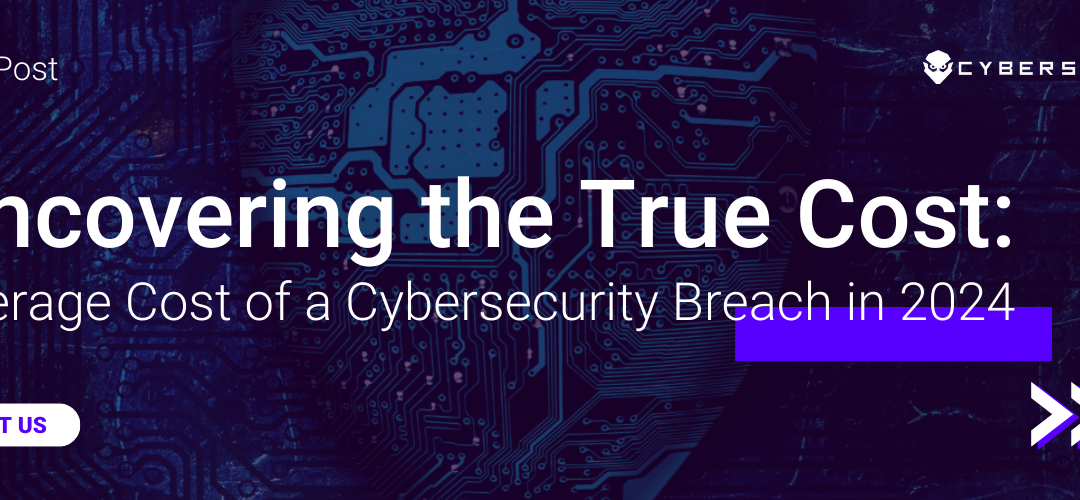Understanding the average cost of a cybersecurity breach is not just a technical issue, but a business one. They can have devastating consequences for small and medium-sized enterprises (SMEs), affecting their reputation, operations, and finances. In an era where data is as valuable as currency, understanding the financial implications of a data breach is crucial for SMEs.
In this article, we will explore the latest statistics and trends on cybersecurity breach costs, the factors that influence them, some real-life case studies, and the cost mitigation strategies that SMEs can adopt, including the role of cyber insurance.
Statistics and Trends
According to the latest report by the Ponemon Institute, the average cost of a data breach in 2024 is estimated to be $4.5 million, a 12% increase from 2020. This figure reflects the comprehensive costs associated with a data breach, such as detection, containment, recovery, notification, legal, regulatory, and reputational costs.
The report also reveals some interesting trends in the industry regarding financial losses:
-
- The average cost per compromised record is $150, a 9% increase from 2020.
- The average size of a data breach is 30,000 records, a 7% increase from 2020.
- The average time to identify and contain a data breach is 280 days, a 5% increase from 2020.
- The most common causes of data breaches are malicious attacks (52%), human error (25%), and system glitches (23%).
- The most expensive types of data breaches are those involving customer personally identifiable information (PII), which cost $175 per record, followed by intellectual property ($165 per record) and employee PII ($155 per record).
- The most affected industries are healthcare ($7.2 million per breach), finance ($5.8 million per breach), and technology ($5.6 million per breach).
- The most affected regions are the Middle East ($6.5 million per breach), the United States ($5.9 million per breach), and Canada ($5.4 million per breach).
These statistics and trends show that data breaches are becoming more frequent, more complex, and more costly for SMEs, posing a serious threat to their survival and growth.
Factors Influencing Costs
The cost of a data breach can vary significantly depending on various factors, such as:
- Number and Type of Records: The more records breached, especially sensitive ones, the higher the cost. For example, a data breach involving 50,000 records of customer PII would cost more than a data breach involving 10,000 records of employee PII.
- Response Time: Quick containment can significantly reduce costs. For example, a data breach that is contained within 200 days would cost 37% less than a data breach that takes more than 200 days to contain.
- Business Size and Sector: Larger businesses and those in sectors like healthcare or finance typically incur higher costs, due to the higher value of their data, the stricter regulatory requirements, and the higher customer expectations. For example, a data breach affecting a large healthcare organization would cost more than a data breach affecting a small retail store.
- Geographical and Compliance Factors: Different regions have diverse data protection laws that can affect breach costs. For example, a data breach in the European Union would incur higher costs due to the General Data Protection Regulation (GDPR), which imposes hefty fines for non-compliance. Similarly, a data breach in California would incur higher costs due to the California Consumer Privacy Act (CCPA), which grants consumers more rights over their data.
- Company Maturity and IT Complexity: Organizations with established cybersecurity measures can often mitigate breach impacts, such as encryption, backup, and incident response plans. For example, a data breach affecting a company with an incident response team would cost 35% less than a data breach affecting a company without one. On the other hand, organizations with complex IT environments can face higher costs, due to the difficulty of identifying and resolving the breach. For example, a data breach involving multiple cloud services would cost more than a data breach involving a single server.
These factors illustrate the multi-faceted nature of breach costs, and the need for a holistic approach to cybersecurity.
Real-Life Case Studies
To better understand the financial impact of a data breach, let us look at some real-life case studies of prominent cybersecurity incidents and their aftermath.
- Equifax: In 2017, Equifax, one of the largest credit reporting agencies in the world, suffered a massive data breach that exposed the personal and financial information of 147 million consumers. The breach was caused by a failure to patch a known vulnerability in a web application. The breach cost Equifax over $1.7 billion in direct and indirect costs, including legal settlements, regulatory fines, customer compensation, security upgrades, and reputational damage. The breach also led to the resignation of several senior executives, including the CEO, and a loss of market value and customer trust.
- Marriott: In 2018, Marriott, one of the largest hotel chains in the world, disclosed a data breach that affected 500 million guests who had stayed at its Starwood properties. The breach was caused by a compromise of a third-party reservation system that had been acquired by Marriott in 2016. The breach cost Marriott over $200 million in direct and indirect costs, including legal fees, notification expenses, security improvements, and customer loyalty programs. The breach also resulted in a 5.6% drop in its stock price, and a potential fine of up to $915 million under the GDPR.
- SolarWinds: In 2020, SolarWinds, a leading provider of IT management software, revealed a sophisticated cyberattack that compromised its Orion platform, which was used by thousands of organizations, including government agencies and Fortune 500 companies. The attack was carried out by a nation-state actor that inserted a malicious code into a software update, allowing them to access the networks and data of SolarWinds’ customers. The attack cost SolarWinds over $100 million in direct and indirect costs, including remediation efforts, legal actions, customer refunds, and revenue losses. The attack also damaged its reputation and credibility and triggered multiple investigations and lawsuits.
These case studies demonstrate the devastating and lasting consequences of a data breach, and the importance of prevention and preparedness.
Cost Mitigation Strategies
While data breaches are inevitable, their costs are not. SMEs can adopt various strategies to minimize the financial impact of a cybersecurity incident, such as:
-
- Implementing robust cybersecurity measures, such as firewalls, antivirus, encryption, backup, and multi-factor authentication, to protect their data and systems from unauthorized access and tampering.
- Educating and training their employees, partners, and customers on cybersecurity best practices, such as using strong passwords, avoiding phishing emails, and reporting suspicious activities, to reduce human error and insider threats.
- Developing and testing an incident response plan, which outlines the roles, responsibilities, and procedures for detecting, containing, recovering, and reporting a data breach, to ensure a swift and effective response.
- Complying with the relevant data protection laws and regulations, such as the GDPR and the CCPA, to avoid legal penalties and liabilities, and to demonstrate accountability and transparency.
- Purchasing cyber insurance, which is designed to offer a safety net against the financial and reputational damages of a data breach. It assesses a company’s risk and size to provide appropriate coverage.
This insurance can cover:
-
- Financial Losses: Direct costs associated with the breach, such as forensic investigation, data recovery, notification, credit monitoring, and identity theft protection.
- Reputational Damage: Costs related to managing public perception post-breach, such as public relations, crisis management, and customer retention.
- Legal Defense and Settlements: Expenses arising from legal actions taken against the company, such as lawsuits, regulatory fines, and compensation claims.
- Accounting and Auditing Costs: Necessary for assessing and rectifying the breach, such as audits, assessments, and certifications.
- Intellectual Property and Defamation Damages: Depending on the coverage, these may also be included.
These strategies can help SMEs reduce the risk and cost of a data breach and enhance their resilience and competitiveness.
Conclusion
The $4.5 million average cost of a data breach is a figure that SMEs should heed, underscoring the need for comprehensive cybersecurity measures and the consideration of cyber insurance as a critical component of their risk management strategy. In a world increasingly driven by technology, the need for robust cybersecurity measures and understanding the complexities of cyber insurance becomes paramount. The escalating sophistication of cyberattacks means that businesses must stay vigilant and proactive in their cybersecurity strategies.
Sources:
- Ponemon Institute: 2024 Cost of a Data Breach Report
- Equifax: Data Breach Settlement
- Marriott: Starwood Guest Reservation Database Security Incident
- SolarWinds: Cybersecurity Update




